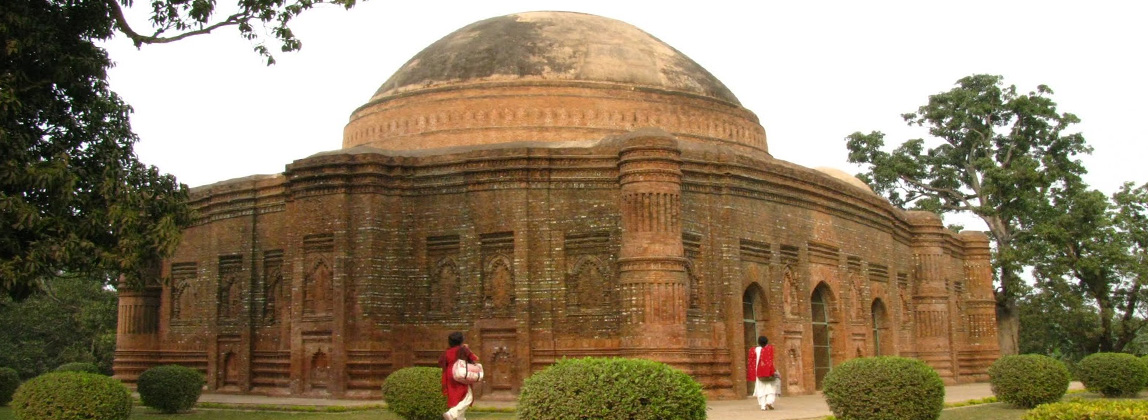


Bengal region of the northeastern part of the Indian subcontinent, It has a total area of about 214,450 sq. km. The western part of the region is occupied by the Indian state of West Bengal, the larger eastern section is occupied almost entirely by Bangladesh, before 1947 the region of Bengal was almost entirely coextensive with the British Indian province of Bengal. The remainder was occupied by the princely states of Couch Bihar and Tripura. In West Bengal most people are Hindus. Christians, Buddhists, Sikhs, Jain and Parsees are the other chief religious groups.
The principal language, Bengali is spoken by more than 90 per cent of the people, however, more than 75 other languages are also spoken throughout the area. The climate of West Bengal is humid and tropical. Rainfall is heavy, ranging from about 1,270 mm to more than 3,050 mm annually During the rainy season from June to October, cyclones from the Bay of Bengal and floods are common. The Bengal was a part of the Mauryan Empire, during the third century B. C. from the forth to sixth century A.D.; Bengal was under the Gupta Empire and this region was first united in the 8th century A.D. under the Buddhist Pala dynasty It was subjugated by Muslim rulers after 1200. From 1576 until the l8th century it was part of the Mughal empire. When mugyal power declined a separate dynasty emerged in & Bengal, Bihar and Orissa, ruled by the Nawabs of Bengal. The nawabs quickly came into conflict with the British and all most all of the region (except Cooch Bihar and Tripura) became a presidency of British India in 1699. In 1937, after a series of changes in territorial and political structure, Bengal became and autonomous provide with a bicameral legislature. In 1945, however, administration was taken over by the British governor.
In 1947, with the achievement of Indian independence and the concurrent division of the country into Hindu India and Muslim Pakistan, the western portion of former Bengal Province became part of India as West Bengal and the eastern portion became East Pakistan. In 1971 East Pakistan became the separate state of Bangladesh. Cooch Bihar became part of West Bengal in 1947, Tripura became a separate state of India in 1972, it was previously a union territory. West Bengal now is bordered on the north by Bhutan and Sikkim, on the east by Bangladesh and Assam. On South by Bay of Bengal, on the southwest by Orissa and on the west by Nepal and Bihar. Most people in Bengal work in agriculture . The chief crop is rice, the principal food of the people. Other important crops include jute, tea, sugarcane and cotton. Jute and cotton precessing are the main industrial activities, other industrial development is limited.
The name Darjeeling is believed to have originated when monks of the Bhutia Busty monastery referred to the region as "Dorjé-ling", meaning the Land of the Thunderbolt.
Darjeeling is often referred to as the QUEEN OF HILL STATIONS. It is located in the state of West Bengal in the Mahabharat Range or Lesser Himalaya at an average elevation of 6,710 ft (2,050 m).
It is internationally renowned as a tourist destination, along with its tea industry and the Darjeeling Himalayan Railway, a UNESCO World Heritage Site. It conjures visions of snow peaks, serenity of vibrant green hills steeped in splendor, a land of breathtaking beauty crowned by the majestic Himalayas. This heavenly retreat is bathed in hues of every shade. Flaming red rhododendrons, sparkling white magnolias, miles of undulating hillsides covered with emerald green tea bushes, the exotic forests of silver fir - all under the blanket of a brilliant azure sky dappled with specks of clouds, compellingly confounds. The crest of Kanchenjunga shining in the first dawn light truly supports the title.
Das Wort Kalim bedeutet "Königsminister" und Pong heißt "Festung". Kalimpong befindet sich im vorderen Himalaya mit Blick auf den Teesta Fluss im indischen Staat Westbengalen. Die einstige Bergstation der britischen Kolonialregierung befindet sich in atemberaubender grüner Kulisse mit schneebedeckten Bergspitzen in der Ferne. Diese einzigartige Szenerie macht Kalimpong zu einem angenehmen Urlaubsziel. Es gibt einen beachtlichen Blumenmarkt in Kalimpong, der sämtliche Orchideenarten anbietet. Die Gartenbauwirtschaft trägt einen wichtigen Teil zur Wirtschaft in Kalimpong bei.
The word Kolkata derives from the Bengali term Kolikata, the name of one of three villages that predated the arrival of the British, in the area where the city eventually was to be established.
Located on the east bank of River Hooghly, Kolkata is the capital of the Indian state of West Bengal. It is also the commercial, cultural, and educational centre of East India, while the Port of Kolkata is India's oldest port as well as its sole major riverine port.
The city's documented history begins with the arrival of the English East India Company in 1690, when the Company was consolidating its trade business in Bengal. Under the East India Company and later under the British Raj, Kolkata served as the capital of India until 1911, when its perceived geographical disadvantages, combined with growing nationalism in Bengal, led to a shift of the capital to New Delhi.
Kolkata has long been known for its literary, artistic and revolutionary heritage. As the former capital of India, Kolkata was the birthplace of modern Indian literary, artistic and scholastic thought. The people of Kolkata tend to have a special appreciation for art and literature; its tradition of welcoming new talent has made it a "city of furious creative energy".
For these reasons, Kolkata has often been dubbed as the Cultural Capital of India or the Literary Capital of India.